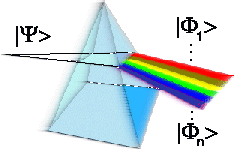A. Orlowski, M. Gajda, P. Krekora, R. J. Glauber, and J. Mostowski
First, we study the scattering of light by a single ultracold, trapped atom initially in the ground state of the trapping harmonic potential. We find interesting features of the scattering in the regime where the atomic recoil energy is much larger than the separation between oscillatory trap levels. Although we present the quan-tum mechanical expression for the scattering cross section, special attention is paid to the semiclassical analysis of the process. We show that the major characteristics of the scattering might be deduced from two conservation laws: conservation of energy and momentum in absorption and emission of photon process separately. These conservation laws impose a strong correlation between scattered-light characteristics and the position of the trapped atom at the moment of photon emission. A detailed analysis of the far-off resonance scattering of light from a single atom trapped in an isotropic harmonic potential is also given. In this case, we are able to assume a more realistic, i.e., thermal, initial state of the atomic center of mass. An exact closed-form expression for the differential scattering cross section is derived from a general S-matrix theory of scattering. The possibility of measuring the density–density correlation functions in light-scattering experiments is discussed.
Opt. Spectrosc. 87, 645 (1999)
Mar 5, 1999
Interference without interference: Directional properties of spontaneous emission
A. Orlowski and W. Zakowicz
A fully quantum-mechanical description of the spontaneous emission from an excited two-level atom placed in front of the two slit interferometer is given. Global modes of the electromagnetic field in a two slit system are derived within the Kirchhoff-Huygens diffraction approximation, serving as a base for the field quantization. The standard Fermi’s golden rule, supplemented by a factor coming from the nontrivial mode structure caused by the presence of the two slit interferometer, is used to show that interference results from the position dependent coupling between the atom and different field modes of the system.
Opt. Spectrosc. 87, 500 (1999)
A fully quantum-mechanical description of the spontaneous emission from an excited two-level atom placed in front of the two slit interferometer is given. Global modes of the electromagnetic field in a two slit system are derived within the Kirchhoff-Huygens diffraction approximation, serving as a base for the field quantization. The standard Fermi’s golden rule, supplemented by a factor coming from the nontrivial mode structure caused by the presence of the two slit interferometer, is used to show that interference results from the position dependent coupling between the atom and different field modes of the system.
Opt. Spectrosc. 87, 500 (1999)
Subscribe to:
Comments (Atom)
